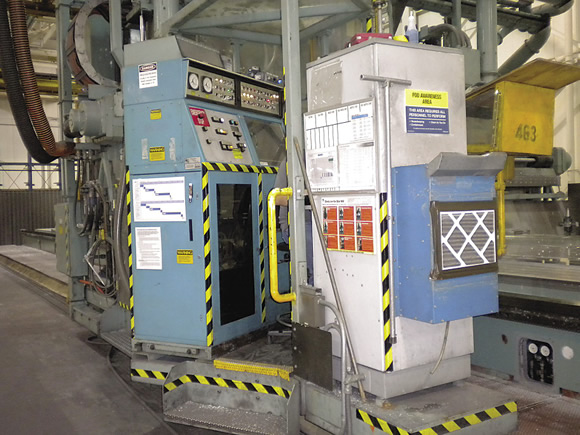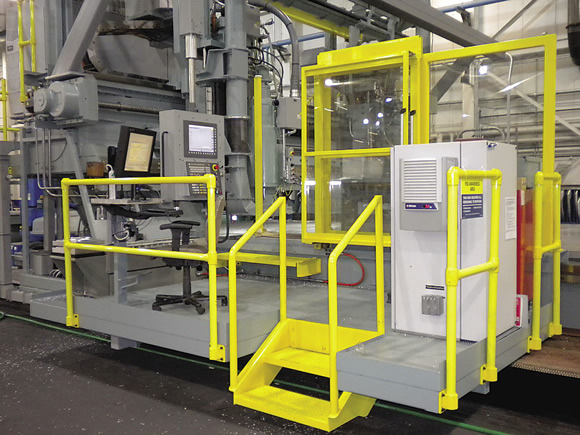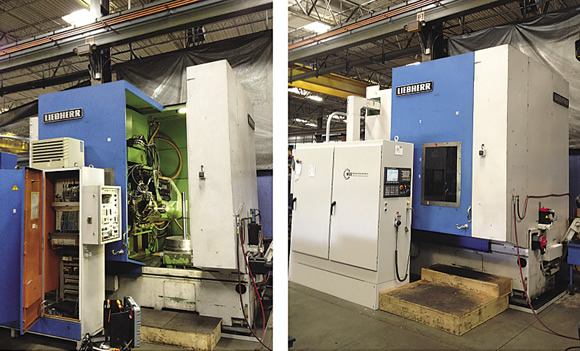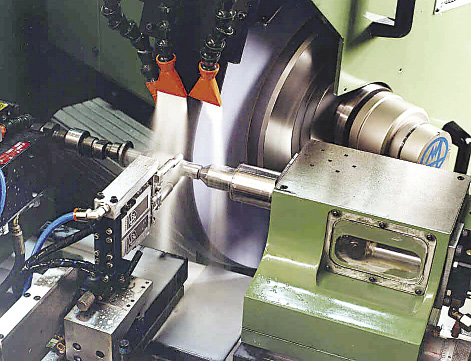Retrofitting old machine tools with new CNCs can make more sense than buying new—particularly for larger machines.
What do you do with a machine tool that is showing its age but still producing good parts? Rather than replace it with a new one, a parts manufacturer can have the machine retrofit with a new control. This lower-cost alternative improves accuracy, reliability and productivity.
“The benefits of retrofitting a machine tool with a new control are cost savings and improved functionality,” said Anne Miner, sales and marketing manager for MTB - Machine Tool Builders Inc., Machesney Park, Ill., a remanufacturer and recontroller of gear cutting and grinding machines. “A control retrofit is approximately 25 to 40 percent of the cost of a new machine, depending on machine type and size.”

Courtesy of CNC Engineering
Before (above) and after (below) images showing a machine operator’s station. The machine tool is a Cincinnati Skin Mill retrofitted with a FANUC 30i Series control by CNC Engineering for a customer in Washington state.

Miner added that although machine tool mechanical parts can last 25 to 50 years, electronic parts have a life cycle of about 12 to 15 years. This is dependent on machine usage (5 to 7 days a week times the number of shifts in operation per day). “Then, the control manufacturer discontinues stocking those parts after 15 years, so when components begin to fail, replacement parts become scarce.”
Ideal candidates for control retrofits are older NC or CNC machine tools that are mechanically sound or performing at an acceptable level. Large machines typically have high replacement values, so retrofitting makes more economic sense for them, Miner noted.
“We do control retrofits mostly on large machines with good foundations that are doing a good job,” said John Blawski, co-owner of Machine Tool Research Inc., Rochester, N.Y., which retrofits, rebuilds and remanufactures machine tools. “We deal with machines that aren’t replaced very often because the foundation is such an enormous expense. We see a lot of grinders, milling machines and especially turning machines.” Most of MTR’s customers are in the power generation and steel industries.

Courtesy of Machine Tool Builders
This Liebherr LC-752 gear hobbing machine received a new electrical cabinet (right) with new electrics, an air conditioner and a control that includes a panel, screen and push buttons. A new servomotor is visible on the exterior of the machine (red and black at bottom right). Within the machine, motors, cabling, absolute scales and other components were replaced.
Not every machine tool is necessarily a candidate for a control retrofit. For many smaller machines used for production volumes, replacement is a better option. “Our control retrofit packages start at $75,000 and go up, so if you can buy a new machine for under $125,000, you are better off buying that machine,” said Gary Caravella, president of CNC Engineering Inc., Enfield, Conn, which performs FANUC control retrofits, mostly for the aerospace and energy and power sectors. The company partners with rebuilding and remanufacturing houses for additional work.
He added that CNC Engineering does control retrofits on higher end or unique small machine tools in addition to large machines. For instance, a lot of grinding machines are small but very accurate. “They make good control retrofit candidates because they are expensive to replace and often are in good shape mechanically because certain grinding operations don’t produce a lot of wear on the machines,” Caravella said.
Most retrofit-ready controls are at least 10 years old, Caravella said, but the majority of controls CNC Engineering retrofits are 20 to 25 years old.
The Typical Package
A retrofit package typically includes an array of components. “The minimum we put in is a new control, operator pendant, servo motors and drives, new cabling to the servomotors and new I/O modules,” Caravella said.
He added that about 30 percent of CNC Engineering’s business is just doing basic control retrofits, while the rest of its customers are looking to add additional options or features.
“The new controls have many enhanced capabilities built into them, like more memory for part program storage and much faster block processing times,” Caravella said. “Block processing times for older controls were in the 100-millisecond range. If the machine was processing a small move, the machine might complete the move before the control had time to process the next block. The machine would then have to pause and wait for the next block. The block processing time of today’s controls can be lower than 1 millisecond. That’s a huge difference and very important when doing die and mold work or 5-axis machining.”
Another enhanced capability is in the feedback system. Today’s encoders have 1 million counts per revolution whereas older machine tools typically have encoders with 2,000 counts per revolution, according to Caravella. This increases machine resolution and allows tighter servoloops, which translates to higher precision on the machine. Also, many controls today use absolute feedback systems that maintain axis positions even when the machine is powered down. This eliminates the need to “zero return” or “home” the machine. (Zero return, or home, is also called the reference point. It is a fixed point on the machine and the value is stored within the control and used as a home position.)
Other Options
Replacing the control on a machine tool is a good time to consider additional upgrades, including new spindle drives and spindle motors, cabling and limit switches, new electrical enclosures, rotary tables, probe systems, gages and balancers.
Another option is installing new feedback systems using scale feedback. Scales mount directly to the machine’s moving axes, thereby detecting actual machine movement. The alternative, an encoder mounted to a servomotor, does not detect any wear in the gear train or ballscrews that drive the axes.
Scales never wear, unlike the mechanical system driving the machine’s axes, so scales add additional accuracy to the machine. “Many older machines have Industosyn scales, which is an obsolete technology, and we usually replace these with modern glass scales,” Caravella said. “We can also add new scales to a machine that doesn’t have them, thereby increasing its accuracy.”
Whether or not to replace wiring on a machine tool is typically determined by the wiring’s age and condition. “My rule of thumb is 30 years,” MTR’s Blawski said. “If you have 30-year-old wiring, you should replace it. If not, you will start having electrical problems in the magnetics because the wires are so old and brittle.” He noted installing a new control, servo motors and drives, and spindle motors and drives requires replacing most of the wiring anyway.
Almost Like New
Shops need to keep in mind that replacing the existing control with a new one is not a panacea for a machine tool’s ills. “A new control does not equal a new machine,” Blawski said. “It doesn’t turn a junk machine into a great machine. The mechanical limitations of the machine still remain.”
But, he added, a new control provides additional speed capabilities in the motors and additional resolution in the feedback. “So if your machine was not making a good circle [when milling] before, it might make a good circle now because the servomotors have a higher response rate and the feedback is at a higher resolution.”
CNC Engineering’s Caravella concurred that the speed of machine operations can sometimes be increased with a new control. “We did a job for a large aerospace customer on a large machine tool with 100 ' of travel and the X-axis feed rate was 300 ipm, which is pretty slow. We installed servomotors that were twice as fast as the old ones and were able to increase the feed rate to 600 ipm on that machine. This rapid rate increase, along with other improvements made during the control upgrade, produced a 40 percent increase in productivity on the machine.”

Courtesy of CNC Engineering
This electrical enclosure with a new control and cabling is ready to be shipped to the customer.
Also, an old machine tool sometimes has untapped capability a new control can reveal. For example, CNC Engineering’s aerospace OEM customer uses dual-spindle vertical milling machines, approximately 12 ' wide × 150 ' long or 25 ' wide × 300 ' long.
“With the old controls, the machines were capable of far more than the controls were,” according to the customer’s equipment engineer. “We put newer generation controls on two of these machines in 1995, and they matched the machines fairly closely as far as capability. The new control is far superior to the 1995 model, as it allows far more sophisticated cutting at a much faster rate in production operations. We have an opportunity now to bring the machine up to the operational level of the new controls.”
He added that the machine tools are 30 to 40 years old and unique to the aerospace industry. The wear parts are easily replaced, keeping the machine mechanically on par with when it was new.
Any mechanical issues, such as worn ways and ballscrews or loose spindles, should be addressed at the same time as a control retrofit. MTR’s Blawski noted his jobs are 50/50 control retrofits vs. full rebuilds or remanufactures.
In addition, MTR often turns manual machine tools into CNC machines. Blawski said: “To do that, you need to make the machine more mechanically accurate. You need to change the slides and the drives, changing the high-friction slideway materials to hydrostatic or antifriction linear ways, and also replace clutch-type gearboxes and leadscrews with servogearboxes and preloaded ballscrews.”
The Final Product
Most control retrofit customers are a FANUC house or a Siemens house—meaning most of their machine tools run on one or the other. Therefore, they want their new controls to be the same brand. Occasionally, a shop will replace a Siemens with a FANUC control or vice versa, but that decision is left to the customer.
Most new controls purchased by retrofitters are generic. The control comes with only standard M-, G-, T- and S-type part program codes built in; there is no software in the CNC to control the machine functions. The control retrofitter must write all the programmable logic control software for a particular machine to run those functions.
“Most large machines require new complex logic, while standard machining centers may have predeveloped logic available,” Blawski said.
Writing that software is the most time-consuming part of the control retrofit process. For an average control retrofit, it takes about 3 to 4 months to engineer and deliver the retrofit package, during which time the machine is still operating. Then, the machine is taken down for installation, startup, debugging and training, which usually requires an additional 2 to 5 weeks.
“It depends on the complexity of the machine,” MTR’s Blawski said. “For a 2-axis machine like a lathe that has a carriage and cross slide, the software might take a week or two to write. But for a complicated horizontal boring mill with a rotary table and head attachment with seven or eight axes, the software might take 6 or 7 weeks to write.”
A typical control retrofit works like this, according to MTB’s Miner: “We send a team of engineers to look at the machine and determine how to put the motors in, how much cabling is needed, where to put the control and so on. The team comes back, orders all of the equipment and starts writing the software. When the parts come in, the engineers do assembly and testing. Then they send the package to the customer’s facility, go to the site and do the installation.”
And the best part is the machine stays up and running, except during the 1- to 2-day evaluation and the approximately 3-week installation. CTE

Courtesy of Marposs
Example of an angle head cylindrical grinder that has been retrofitted with a modern apparatus. The Unimar in-process gage (foreground) automatically monitors the part diameter while grinding in order to control finished part size. The dynamic wheel balancer mounted on the grinding wheel spindle automatically compensates for an out-of-balance condition as dressing reduces the grinding wheel size.
Accessorizing a machine control retrofit
To further increase a machine tool’s productivity, control retrofitters often install additional accessories. These can include additional axes, rotary tables, lasers for tool setting and touch probes.
Seeing the value in retrofitting and upgrading these accessories, Marposs Corp. formed a dedicated group to do just that. The global retrofit services group has been around for 2 years, but Marposs has performed retrofits for many years.
“The retrofit industry has definitely changed,” said Frank Powell, product manager for Marposs, Auburn Hills, Mich. “In the U.S., retrofitting used to yield a bigger tax savings than buying new. In the 1980s, the retrofit business in the U.S. represented 50 percent of our business. Then tax laws changed to where it made sense to always buy new. The attitude has changed again since the most recent financial crisis. Companies are looking at retrofits and upgrades again as a way to save money, so Marposs started its own retrofit group—worldwide.”
Marposs provides services for adding process control devices to machine tools. It can add devices to machines with existing controls or it works with system integrators that replace the controls too. Typical process control devices include automatic wheel balancers, acoustic sensing part positioners, gap and crash sensors and in-process gages.
After finding out what the customer wants, Marposs engineers determine if the devices can be added to the machine tool as is. If they discover the control doesn’t have the capacity or is beyond Marposs’ ability to modify, they recommend the customer involve a control retrofitter for replacement of the control. Depending on how the customer wants to handle it, the control modification, along with the Marposs retrofit, can be purchased through Marposs or the controls integrator.
“We can add only within the realm of what that existing control can do,” Powell said. “We have to make sure the control has the capability, both in power and intelligence, to be able to be modified to add the feature.”
In most cases, the additional devices—such as balancers and gages for grinding machines and touch probes for lathes and machining centers—are standard items, so most control retrofitters have functions in their software available for these items.
Many of the machine tools that are candidates for retrofit today were built in the 1980s and have provisions for these additional functions, which were optional at that time.
“A big reason our customers do retrofits is labor savings,” Powell said. “Our devices allow more automated functions that would normally require a skilled machinist. They also allow for more uniformity in production.”
— S. Woods
Contributors
CNC Engineering Inc.
(860) 749-1780
www.cnc1.com
Machine Tool Builders Inc.
(815) 636-7502
www.machinetoolbuilders.com
Machine Tool Research Inc.
(585) 288-4600
www.mtrnet.com
Marposs Corp.
(248) 370-0404
www.marposs.com
Related Glossary Terms
- boring
boring
Enlarging a hole that already has been drilled or cored. Generally, it is an operation of truing the previously drilled hole with a single-point, lathe-type tool. Boring is essentially internal turning, in that usually a single-point cutting tool forms the internal shape. Some tools are available with two cutting edges to balance cutting forces.
- centers
centers
Cone-shaped pins that support a workpiece by one or two ends during machining. The centers fit into holes drilled in the workpiece ends. Centers that turn with the workpiece are called “live” centers; those that do not are called “dead” centers.
- computer numerical control ( CNC)
computer numerical control ( CNC)
Microprocessor-based controller dedicated to a machine tool that permits the creation or modification of parts. Programmed numerical control activates the machine’s servos and spindle drives and controls the various machining operations. See DNC, direct numerical control; NC, numerical control.
- dressing
dressing
Removal of undesirable materials from “loaded” grinding wheels using a single- or multi-point diamond or other tool. The process also exposes unused, sharp abrasive points. See loading; truing.
- feed
feed
Rate of change of position of the tool as a whole, relative to the workpiece while cutting.
- gang cutting ( milling)
gang cutting ( milling)
Machining with several cutters mounted on a single arbor, generally for simultaneous cutting.
- grinding
grinding
Machining operation in which material is removed from the workpiece by a powered abrasive wheel, stone, belt, paste, sheet, compound, slurry, etc. Takes various forms: surface grinding (creates flat and/or squared surfaces); cylindrical grinding (for external cylindrical and tapered shapes, fillets, undercuts, etc.); centerless grinding; chamfering; thread and form grinding; tool and cutter grinding; offhand grinding; lapping and polishing (grinding with extremely fine grits to create ultrasmooth surfaces); honing; and disc grinding.
- grinding wheel
grinding wheel
Wheel formed from abrasive material mixed in a suitable matrix. Takes a variety of shapes but falls into two basic categories: one that cuts on its periphery, as in reciprocating grinding, and one that cuts on its side or face, as in tool and cutter grinding.
- inches per minute ( ipm)
inches per minute ( ipm)
Value that refers to how far the workpiece or cutter advances linearly in 1 minute, defined as: ipm = ipt 5 number of effective teeth 5 rpm. Also known as the table feed or machine feed.
- lathe
lathe
Turning machine capable of sawing, milling, grinding, gear-cutting, drilling, reaming, boring, threading, facing, chamfering, grooving, knurling, spinning, parting, necking, taper-cutting, and cam- and eccentric-cutting, as well as step- and straight-turning. Comes in a variety of forms, ranging from manual to semiautomatic to fully automatic, with major types being engine lathes, turning and contouring lathes, turret lathes and numerical-control lathes. The engine lathe consists of a headstock and spindle, tailstock, bed, carriage (complete with apron) and cross slides. Features include gear- (speed) and feed-selector levers, toolpost, compound rest, lead screw and reversing lead screw, threading dial and rapid-traverse lever. Special lathe types include through-the-spindle, camshaft and crankshaft, brake drum and rotor, spinning and gun-barrel machines. Toolroom and bench lathes are used for precision work; the former for tool-and-die work and similar tasks, the latter for small workpieces (instruments, watches), normally without a power feed. Models are typically designated according to their “swing,” or the largest-diameter workpiece that can be rotated; bed length, or the distance between centers; and horsepower generated. See turning machine.
- milling
milling
Machining operation in which metal or other material is removed by applying power to a rotating cutter. In vertical milling, the cutting tool is mounted vertically on the spindle. In horizontal milling, the cutting tool is mounted horizontally, either directly on the spindle or on an arbor. Horizontal milling is further broken down into conventional milling, where the cutter rotates opposite the direction of feed, or “up” into the workpiece; and climb milling, where the cutter rotates in the direction of feed, or “down” into the workpiece. Milling operations include plane or surface milling, endmilling, facemilling, angle milling, form milling and profiling.
- milling machine ( mill)
milling machine ( mill)
Runs endmills and arbor-mounted milling cutters. Features include a head with a spindle that drives the cutters; a column, knee and table that provide motion in the three Cartesian axes; and a base that supports the components and houses the cutting-fluid pump and reservoir. The work is mounted on the table and fed into the rotating cutter or endmill to accomplish the milling steps; vertical milling machines also feed endmills into the work by means of a spindle-mounted quill. Models range from small manual machines to big bed-type and duplex mills. All take one of three basic forms: vertical, horizontal or convertible horizontal/vertical. Vertical machines may be knee-type (the table is mounted on a knee that can be elevated) or bed-type (the table is securely supported and only moves horizontally). In general, horizontal machines are bigger and more powerful, while vertical machines are lighter but more versatile and easier to set up and operate.
- numerical control ( NC)
numerical control ( NC)
Any controlled equipment that allows an operator to program its movement by entering a series of coded numbers and symbols. See CNC, computer numerical control; DNC, direct numerical control.
- process control
process control
Method of monitoring a process. Relates to electronic hardware and instrumentation used in automated process control. See in-process gaging, inspection; SPC, statistical process control.
- turning
turning
Workpiece is held in a chuck, mounted on a face plate or secured between centers and rotated while a cutting tool, normally a single-point tool, is fed into it along its periphery or across its end or face. Takes the form of straight turning (cutting along the periphery of the workpiece); taper turning (creating a taper); step turning (turning different-size diameters on the same work); chamfering (beveling an edge or shoulder); facing (cutting on an end); turning threads (usually external but can be internal); roughing (high-volume metal removal); and finishing (final light cuts). Performed on lathes, turning centers, chucking machines, automatic screw machines and similar machines.






